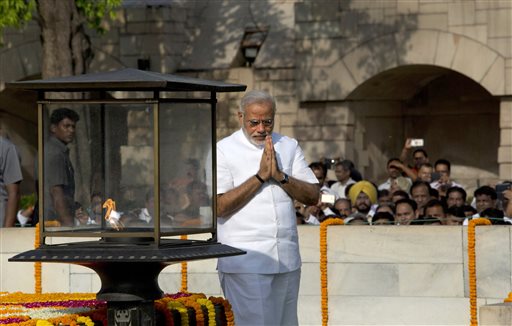
Indian Prime Minister-designate and Hindu nationalist Bharatiya Janata Party leader Narendra Modi pays his respects at Rajghat, the memorial of Mahatma Gandhi, in New Delhi, India, Monday, May 26, 2014. Modi, 63, will be sworn-in as the India’s Prime Minister on Monday evening by President Pranab Mukherjee at the forecourt of the Indian presidential palace. AP
MUMBAI – India’s stock market surged past the 25,000 mark Monday as Narendra Modi prepares to be sworn in as prime minister, with investors betting his new cabinet will unleash reforms to revive the economy.
The Bombay Stock Exchange’s benchmark index rose 1.95 percent in morning trade to 25,175.22 points, close to the peak of 25,375.63 points reached on May 16 when Modi’s landslide election victory was announced.
“The return of the markets to 25,000-plus levels shows that the gains we saw on election day were not a bubble or a hope rally. People really expect this government to perform well,” said Alok Churiwala, head of Churiwala Securities based in Mumbai.
The Indian rupee also gained strength, climbing to an 11-month high of 58.41 to the dollar.
Modi’s Hindu nationalist Bharatiya Janata Party (BJP) won a decisive mandate for reform and is expected to steer India firmly to the right after 10 years of rule by the leftist Congress party.
Modi and his cabinet are to be sworn into office in New Delhi on Monday evening, and the premier-elect has already signalled bold intentions by announcing plans to slash the number of ministers in his government.
The cabinet, including the key post of finance minister, has not yet been announced.
Churiwala said Modi’s invitation to Pakistani counterpart Nawaz Sharif to attend the ceremony, in a bid to improve strained ties between the rival neighbors, had “gone down very well with investors”.
“It shows Modi can rise to the occasion and dialogue is appreciated,” Churiwala added.
But some analysts warned the market was being too optimistic given that long-term policies focused on structural reforms, rather than quick fixes, were needed to turn the economy around.
“Right now the market is moving up on hope and not factoring in any negatives. Ground realities remain the same,” said Rahul Bhandawat of Equentis Capital.
A hefty fiscal deficit, stubbornly high inflation and sluggish exports are some of the key challenges the new government will have to address before it can unleash India’s economic potential, analysts say.